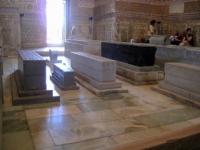Вы здесь
Tomb of Ulugbek.

Weekend tours in Uzbekistan.
"Everyone is moving up to the date determined for him, when his life reached this border and the term, fixed by relentless fate, expired, his son did lawlessness towards him and struck the father with a blade of a sword. He met his martyr death in desert, going the mercy house of all-forgiving God, on 10 ramadan 853". In Gur-Emir, only Ulugbeg is buried in clothes, what in Muslim tradition is allowed only to martyrs - "shahids"
Fam trip in Samarkand.
Mirzo Ulugbeg (1394 - 1449) became a governor of Maverannahr and Turkistan in 1409, when his father Shahruh took the supreme power in the Temurid state. In 1413 - 1414, Khorezm became a part of his empire.
In 1414, Ulugbeg conquered Fergana. In the 1420s, Ulugbeg did attempts to interfere in the struggle for the power in Mogolistan and ulus of nomadic Uzbeks. However, in 1427, the Temurid army headed by Ulugbeg and his brother Muhammad Djuki was defeated in the battle with the nomadic Uzbeks near Sygnak.
The Uzbek troops pursued them down to Samarkand. To daunt the nomads, Shahruh had to arrive with a huge army to Samarkand. The next twenty years were peaceful. On the death of Shahruh in 1447 - 1448, Ulugbeg, together with his son Abdullatif, twice made campaigns to Khurasan and took Herat.
Abdullatif stayed in Heart to govern, but in 1449 rose in rebellion against the father. He arrived with the army to Samarkand and dethroned Ulugbeg. Among some other reasons, personal horoscopes of Ulugbeg and Abdullatif, which provided mutual "troubles", might predetermine their conflict.
Ulugbeg was permitted to do hajj, but en route he was killed under order Abdullatif. The killer cut off his head. At the reign of Mirzo Ulugbeg, most likely, in the 1430s - 1440s, Gur-Emir necropolis was much extended.
The eastern gallery, now serving the passage to the central hall was built in that period. At the southern (back) side was constructed a big memorial complex. Just remains of the gallery and two underground burial chambers have been kept.
One of them was close to the chamber of Amir Temur by its decor and, probably, was prepared for Mirzo Ulugbeg. However, his tragic fate stirred these plans. He was buried in a marble sarcophagus in the southern niche of the central chamber at Amir Temur's foot.
The inscription in Farsi on the gravestone from a grey marble reads: This light-bearing tomb, this honoured place of martyrdom, this smelling sweet garden, this inaccessible tomb is a place of last calm of the king.
The king, having gone down to it, pleased the gardens of paradise and made happy paradise flowers. He is - the forgiven sultan, the pleased caliph, serving to the world and belief. Ulugbeg - sultan, - let Allah light his tomb! - which happy birth happened in 796 in Sultaniyyah.
In zi-l-hidjj 810, in the city of Safety, in Samarkand, he became a vicarious ruler. Submitting to the order of Allah: "Everyone is moving up to the date determined for him, when his life reached this border and the term, fixed by relentless fate, expired, his son did lawlessness towards him and struck the father with a blade of a sword.
He met his martyr death in desert, going the mercy house of all-forgiving God, on 10 ramadan 853". In Gur-Emir, only Ulugbeg is buried in clothes, what in Muslim tradition is allowed only to martyrs - "shahids".
Authority:
Alexey Arapov. Samarkand. Masterpieces of Central Asia. Tashkent, Sanat. 2004.
Photos
Alexander Petrov.







